November 8, 2023

Co-op video games have been around since the 1970s when the arcades first introduced the Pong doubles game. Although the genre has come a long way since then, there is a constant appreciation for it over time among the players. Essentially, co-op is a sub-genre of multiplayer games with the defining trait being that the gamers assist each other in beating the game as opposed to competing with each other in other words, it is a “cooperative” gameplay. Sounds interesting, right? In this article, I will try to make a case of how different games have tried to design such an experience and how Journey’s co-op tries to differ from the conventional designs of implementations in other games.
First of all, one may ask, how many types of co-op are there? Easy, there are two. One is a local co-op(also known as couch co-op) and the other is an online co-op. As you may have guessed by their names, local co-op games are meant to be played locally with more than one controller or multiple input options usually with the screen split in two or more parts while online co-op games are played via LAN or the internet from different devices altogether. If we take examples, Unravel Two, Luigi Mansion 3, Mortal Kombat : Shaolin Monks, etc. are local co-op games, while games like Death Stranding, Call of Duty, CS:GO, Rocket League, Among Us fall into online co-op and games like It Takes Two, A Way Out, Portal 2, etc. are playable in both modes. However, for the scope of this article, we will only consider Player vs Environment(PvE) games i.e. games where the players have to beat the computer rather than compete against other players in teams(for eg. PUBG where players play in a team to eliminate remaining teams).

Unravel Two’s co-op gameplay
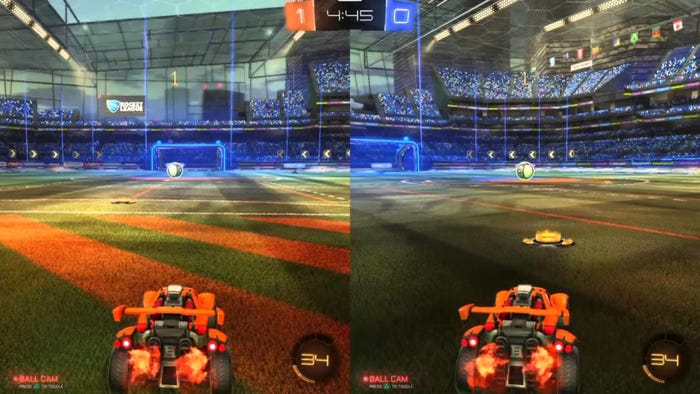
Rocket League co-op gameplay
Now, let us consider the design principles that PvE co-op games are built upon so that we can achieve a better understanding. Usually, co-op games require verbal communication from players either through physical talking, voice chat, text chat or choice-based texts and can usually play with people whomever they want to. Aside from that, there are several games that encourage working together by allowing players to combine moves and combat to deal extra damage to enemies. For this article, we will follow a classification of co-op games by Thierry Lauret in this article. It divides the play style of PvE co-op games into four different types which are used individually or mixed together for designing such games. As detailed in the article, these are the four categories of co-op gameplay design:
-
Designing for the gate: In this type, players need not work with each other until a gate that can only be opened by collaboration or such environmental obstacle, blocks them. Here, one player cannot move ahead on their own even if they have completed the challenge if the team is not moving. Examples of this can be seen in games like Splinter Cell, Call of Duty, etc.
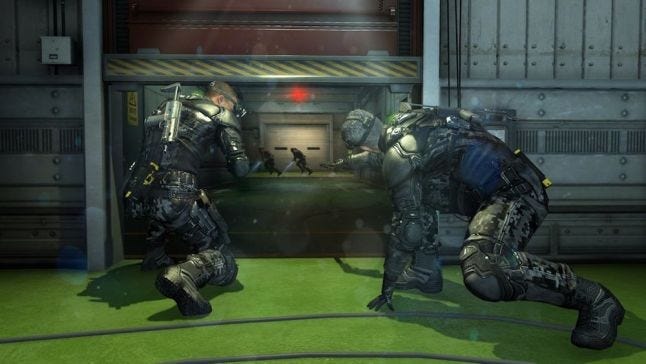
Splinter Cell’s gate co-op design. Players can play on their own but if they want to move ahead, they can only do so together.
-
Designing for the comfort: This type makes it possible for a single player to complete a challenge but makes it incredibly difficult to do so. A highly skilled player can move through the game alone but taking help from other players will make the game easy. Examples that use this include Phasmophobia, Left for Dead, World of Warcraft, Mortal Kombat : Shaolin Monks, etc.
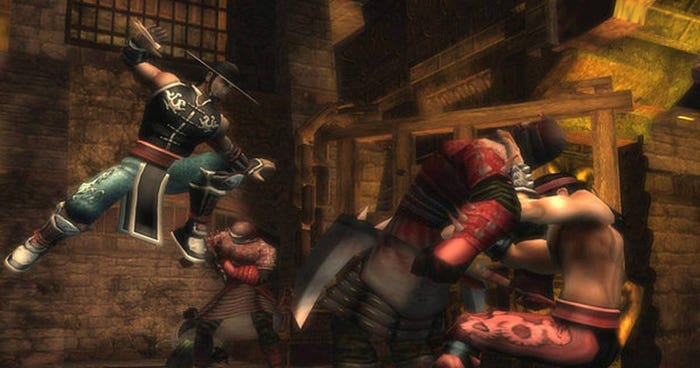
Mortal Kombat : Shaolin Monks’ comfort gameplay design. Players can complete the same quest with one player
-
Designing for the class: Players have a unique characteristic in this type and it can be in skills, environment, or handicap. A specific task is only created for a player characteristic and can be accomplished only by a character that possesses that skill. So, every player has a different objective to complete and requires communicating with other players to move forward in the game. Some games that implement this are Keep talking and nobody explodes, Rayman Legends, etc.
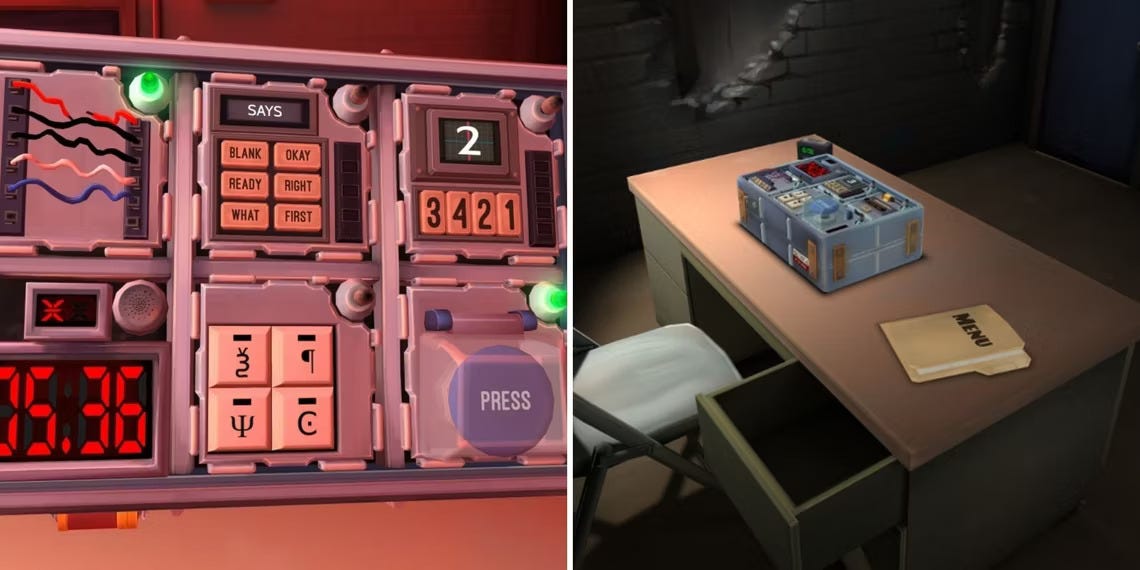
Keep Talking and Nobody Explodes’ class co-op design. Player characters have specific roles in a co-op mode and they need to complete tasks specifically created for them, in order to win.
-
Designing for the job: This gameplay type is similar to the previous class co-op design but is usually without specialization in terms of tasks and roles. In-game characters with exact same capabilities can exist and each player has enough capability to accomplish any task but they cannot do it alone. They will need others to progress through the game. Some examples of this type of gameplay are Portal 2, It Takes Two, etc.
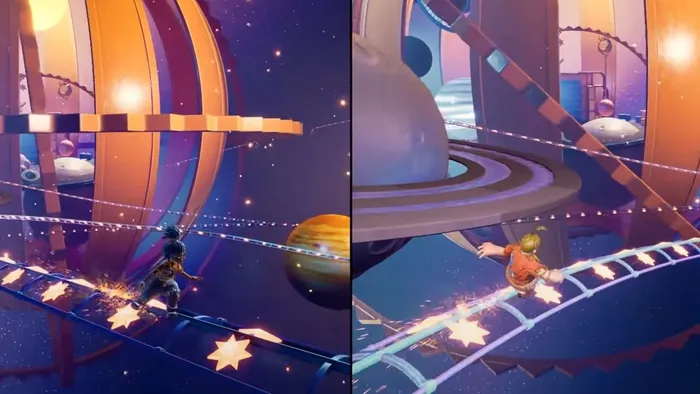
It Takes Two’s job co-op design. Any of the characters can do the tasks but they need to work with each other to do it.
However, when we look at how Journey implements co-op, we can find that it manages to subvert these categories and it does that, by intended design. In Journey, a player begins the game alone with a clear goal that is visible in front of them. When the player moves forward in the game a little, they come across another level and this is when they are able to see another anonymous player with no username or any identification, wandering around, trying to reach the mountain. However, players can only communicate via chirps which can also recharge the other player’s cloth which is a requirement for levitating in the game. Apart from this, there is a visually and aesthetically pleasing warm color and effect when two players get close to each other while recharging each other’s scarves and it strikes an important contrast to the cold and icy environments in the later level when the hero reaches the dark depth of the journey which signifies a feeling of companionship. Also, thanks to the dynamic soundtrack in Journey, if a player travels alone, they hear a different tune and when traveling closely with a companion, an extra set of instruments starts playing and this makes both the experiences of completing the Journey extremely unique. Even a single player can finish the journey alone as there are alternative red cloths floating around which give the player the ability to levitate.
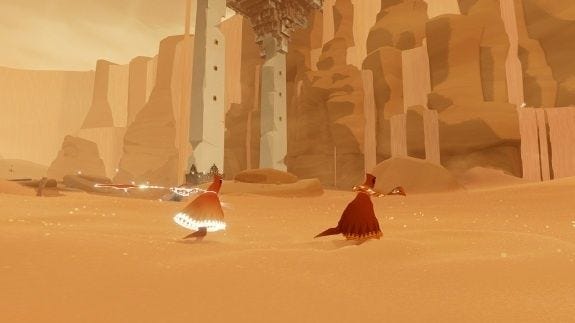
Journey’s co-op gameplay
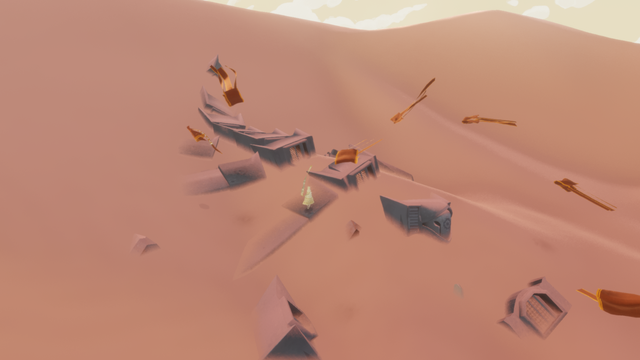
Single-player gameplay showing red cloths in Journey that can recharge the scarf of the player to levitate.
So how does this design of Journey’s co-op differ from the regular co-op games? Creative Director, Jenova Chen envisioned Journey initially to change the emotional feel of a multiplayer game. The team iterated on several prototypes of co-op gameplay before settling on the current one. This process allowed them to redesign the gameplay and subvert the normal tropes of co-op games. If we take the 4 atoms as described by Thierry Lauret above, we can see that Journey moves away from all those categories that define the majority of the cooperative genre. We can see from the four atoms that the gate, the class, and the job, in essence, force a player to collaborate with the other player which can sometimes lead to situations where players can start disturbing the gameplay to tease other players and cause frustration. Even the comfort co-op design, which allows a player to beat the game alone, prevents them from doing so by increasing the difficulty, thereby making an effort to force the players to work together. But Journey, on the contrary, tries to give a single player the same emotional and gameplay experience even when playing in multiplayer. Even if a player decides that they do not want to continue with the other person or move at their own pace or they decide that they want to travel with the player and wait for them if they get left behind, both are possible. Journey makes single-player and co-op different experiences rather than making them better or worse. Essentially, in contrast to other co-op titles that make players work or fight or travel together because they need to, Journey allows players to travel together because they want to.
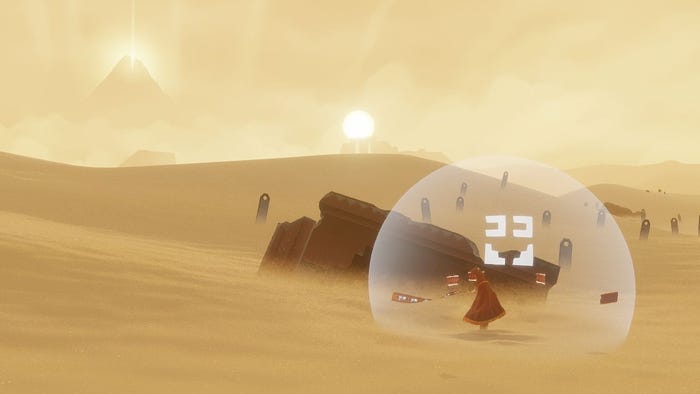
Using the chirp mechanic in single-player gameplay to call the red cloths nearby that give the character the ability to levitate.
An independence of exploration in Journey even while playing in a co-op mode, allows players to stay in the emotional and surreal environment and experience that the game wants the players to dive into. If there were any compulsions to work or collaborate together, the player’s attention would be divided into experiencing what they were going through in the game and in thinking how to interact with the other players.
Apart from this, they also experimented with various ways for players to communicate like thumbs up and thumbs down buttons, chat, etc. but they were able to realize that when left to themselves, players would use more negative emotions like the thumbs down button. This would break the player experience and the feeling of peaceful and calm setting they were trying to achieve. As their initial release was on a console that could not include a keyboard, they decided to implement a ping which would either be a short one or a large one.
Chen says, “Instead of [all that other stuff], we just turned communication into a ping. When you ping very quickly, you come across as quite urgent. When you ping large, it seems like you are calling. In prototyping and playtesting we found that was kind of ambiguous. People might know you are mad, but they don’t hear you cursing at them.”
This turns emotions into an abstract form as words are not used thereby not distracting the player even if they feel that the other player is trying to say something negative.
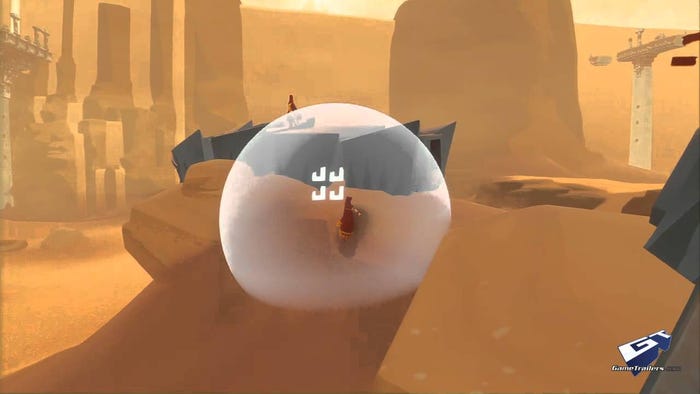
The chirp mechanic used in co-op gameplay to convey something in an abstract notion to the other players.
Conclusively, Journey has tried to redesign the ways in which people interact online in a significant way. Although the design methods used in the game have been towards achieving a specific end goal of an experience and cannot be directly applied everywhere, it surely can be used as a reference point for the design of future games that want to create meaningful and emotion-rich co-op experiences that can create a transformation in the players.
Read more about:
Blogs
About the Author
You May Also Like





